Why did the chicken cross the road?
by Rachael
Luang Prabang to Phonsavanh, Laos
We don’t know why – but we did see lots of them trying to on the road from Luang Prabang to Phonsavanh. And I mean dozens, not two or three.
We are bouncing down the hill away from LP, having crept up the other side at 15km/hr. With every bump, a little cloud of dust rises from each seat. This bus used to have a blue and white interior – now it is varying shades of brown on brown, and when the passengers stand up, you see their clothes have also turned brown.
Under the dust cover, there’s not one seat without torn upholstery, the rips revealing brown dusty foam. By the end of eight hours I’m sure we’ll be super thankful for the foam!
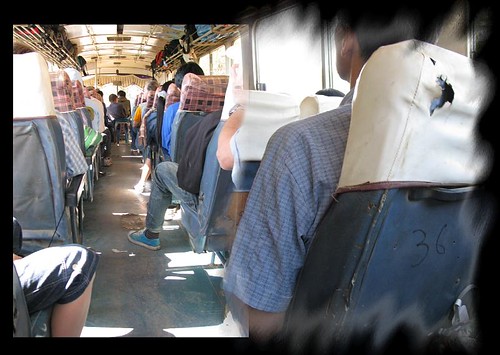
When we go around a particularly sharp left-hand corner, Jgirl14’s seat tips sideways and the man across the aisle throws his leg out in automatic response to steady it. This was amusing…..the first few times!
From our back seat vantage point we can see the overhead luggage rack, stuffed full to overflowing, jiggling and bouncing about; one side is decidedly more secure than the other.
You’d expect a bit more from a VIP bus, wouldn’t you? Indeed, you should get airconditioning and clean seats, not to mention a faster trip. But we are not on a VIP bus. Did we book a VIP bus? Yes, we did. Did it cost more than a local bus? It certainly did.
But when we arrived at the bus station, there was only one bus going to Phonsavanh, and there was nothing VIP about it.
We secured ourselves seats on said bus *just in case* it was the only one, and then I went enquiring about the advertised-at-the-ticket-booth-window-VIP-bus.
“No have Madame. Phonsavanh only one bus. Local bus. How much you pay?”
“95,000 kip. Not 85,000 kip.”
“I give you.”
And so I gratefully received a 10,000 kip times eight tickets refund – and an adventure to boot!
Right now Mboy6 is exclaiming in absolute awe and wonder, “WOW! What a view, Mum. What a view. Look! I wouldn’t think mountains would be higher than clouds. WOW. It’s like flying. We’re above the clouds.”
Although the ears are popping, there’s not much further resemblance to flying. I don’t think there are going to be any in-flight movies or airline meals – good thing we brought our basket of sticky rice!
But it’s true, the view IS awesome. Far below us is a sea of fluffy marshmallow clouds, and poking up from them, towering above them, is a round-humped mountain range. Framing the view is an assortment of bamboo, banana palms, toi-toi-like grasses and the ubiquitous “firewood trees”.
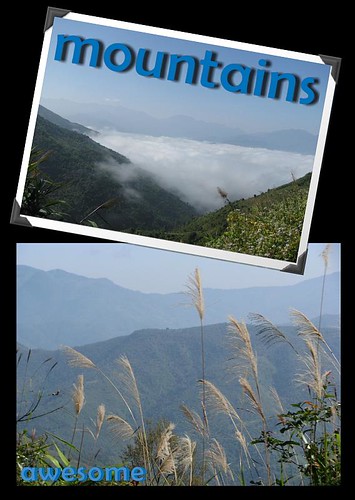

As the sun burnt the mist off, we continued to climb and climb and climb. We kept expecting to start the descent, but we just went up, up, up. Admittedly, we were not going fast, but even still, it was quite some climb (4,000 metres to be precise). When we got to the top, we did not go over and down. For hours we crawled along the ridge, occasionally gathering some speed down a short stretch of road, only to return to another slow uphill chug.
Cliffs dropped away sharply, sometimes on both sides of the road. In more than a few places the road itself had been taken down the cliff in a landslide.
![]()

Every so often bundles of grass and thatching laid out to dry in the sun, lined the side of the road, announcing the imminent arrival of another village. Each village was different, but they all had things in common. You could not say the huts perched on the cliffs – they *clung* on, overhanging severe drops to the valleys below. They also hugged the road. So close were they, you could reach your arm out the window and touch the thatched roofs – or take one of the bright red chilies drying on bamboo trays on the roofs. The huts themselves were made primarily of split bamboo with some timber and/or concrete and/or stone, with doorways that might or might not be filled with a door and shuttered windows.

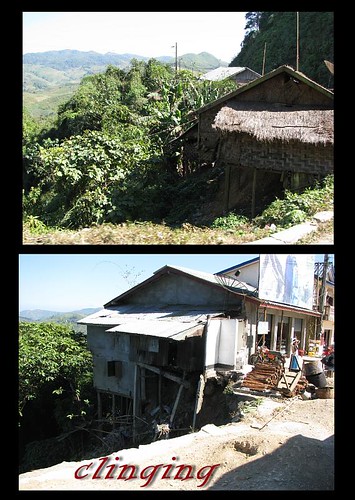
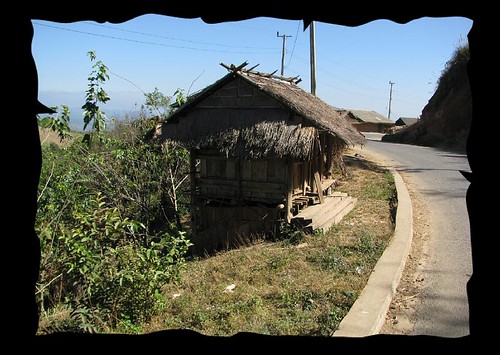
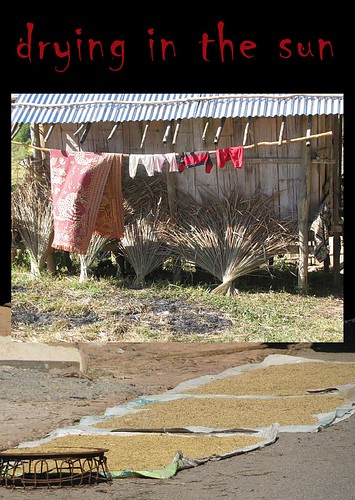

Down at ground level rice was laid out on sacks and tarpaulins, drying out for monsoon storage. Chickens pecked in the dust (and crossed the road – heehee), turkeys gobbled around, ducks waddled under houses, dogs ran everywhere and pigs snuffled in piles of food scraps. Naked children scampered about. Clothed ones played or helped out with chores, carrying and stacking firewood, caring for younger siblings, and even very young children were threshing grass bundles at the side of the road. I saw small children playing with big knives, small children far from any visible adult, playing in the drain by the road, babies being carried by children not much bigger than themselves. Women sat on the ground expertly folding grass over a stick to make new thatching. Others ground spices, fed babies, swept the dirt or hung washing out to dry on bushes, bamboo poles, fences, firewood stacks and roofs.
Every village had one or more communal taps, each set on a concrete pad. Here people gathered to wash vegetables by the bucketful and to perform personal ablutions.
We drove past them, village after village, with people eating bowls of noodle soup in each one, living their daily lives.
And we quickly came to understand that so long as you honk your horn, you can overtake a bus regardless of what might be coming around the blind corner!
Seven hours we’ve been travelling when we reach the crest of yet another hill. Spread far below us are acres of brown rice paddies. The paths criss-crossing them are dark brown, standing out against the lighter spent rice stalks. There’s an earthy beauty about the scene.
Down we hurtle. Down, down. Back and forth across the face of the mountain the road winds, but ever downwards. Soon we are driving through the paddies. The beauty remains.
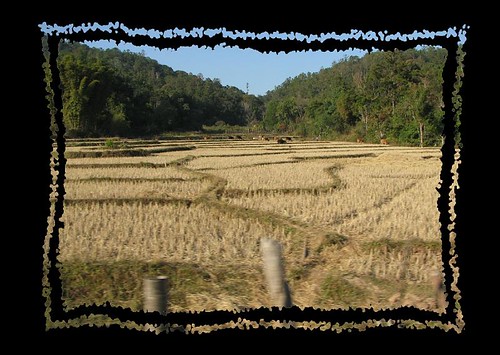
This marks a change in the landscape. Bamboo gives way to pine trees. Scraggly pine trees, but pines nonetheless. The hills turn from steep to rolling and in places are covered with grass. For a short while it looks distinctly New Zealand-ish (except for the clumps of banana palms and the dark dark brown grass).
Then we start wondering if we’ve been on the bus for too long. The red soil makes us think we’ve been transported to the Australian outback. What’s more, there are gum trees – yes, eucalyptus trees in the red soil of Laos. If this were an aeroplane, we could have flown from Singapore to Sydney by now, but this is no plane (it’s not even a VIP bus) and we’re slowing down for a buffalo to get off the road, and out the window there are two lines of Hmong youth throwing balls to each other – the two week long New Year celebrations draw to a close this weekend.
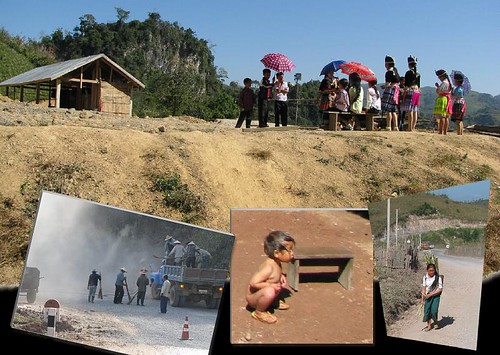
The sun is setting on both long-standing traditions and what turned out to be a not-so-long bus ride (eight truly interesting hours, but covering only 249kms!) Just before we pull into the bus station, another chicken crosses the road.

Tags: children, food, housing, money, postcard: Laos, price, quote, recreation, tradition, transport




What an epic journey, VIP or no VIP bus! You could have been describing the journey from Tansen to Pokara in Nepal, the terrain and the way of life seems to be identical, except in nepal you see woman after woman returning home with a basket load of feed for the buffalos on her back
I’m pleased that the kids found it interesting too. I had not realised that Laos had such lofty mountain ranges. Looking at the terrain on Google earth, I was wondering, how on earth do they get a road through that lot. Now I know!
Oh, I knew we missed something…the ladies with baskets of buffalo feed or baskets of firewood, some carried on poles over their shoulders, some with a strap across their foreheads!
[…] trip in Laos we saw so many chickens crossing the road that we lost count. We may even have blogged about it. But ever since then, the question has HAD to be asked whenever we have seen something […]